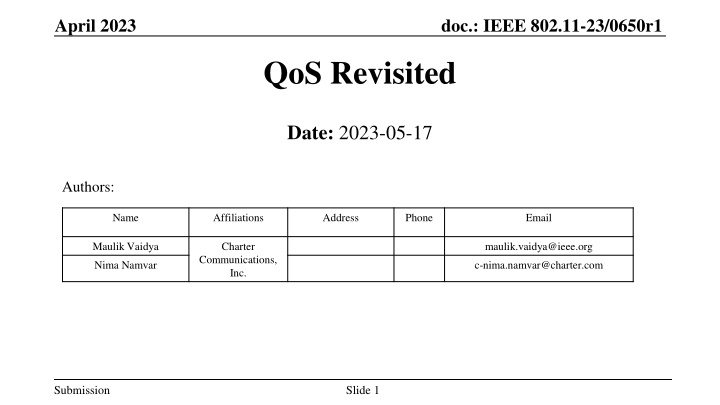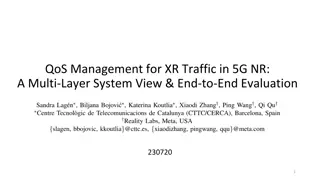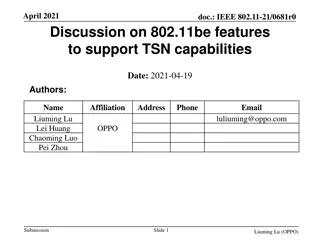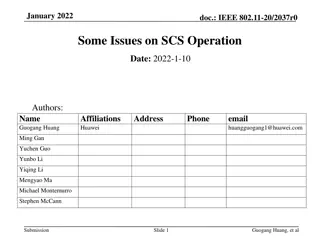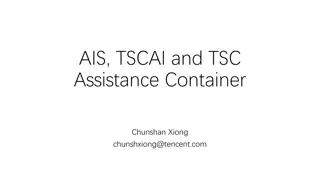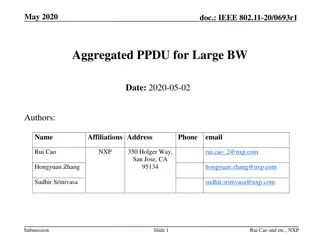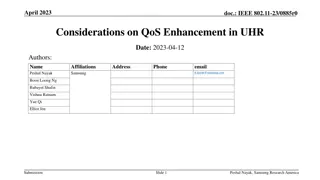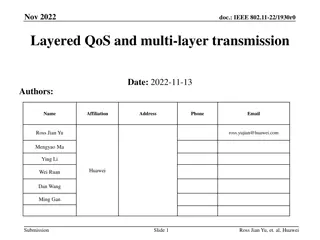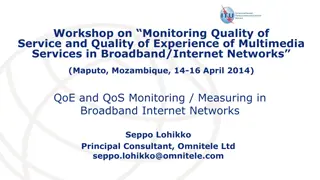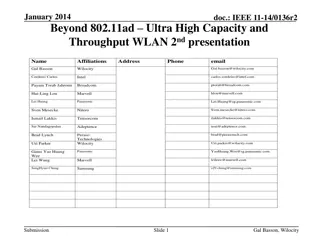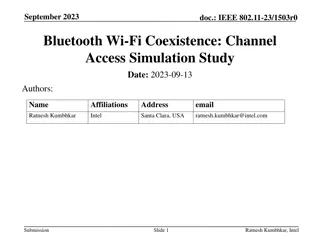Enhancing QoS Facility for Low-Latency High-Throughput Performance in IEEE 802.11 Networks
This proposal addresses the shortcomings in traffic classification and handling of uplink/downlink traffic in current IEEE 802.11 specifications, particularly in relation to low-latency traffic. It also highlights issues with the current EDCA mode in managing congestion and proposes high-level solutions to address these shortcomings. The focus is on improving the Quality of Service (QoS) facility to support interactive, high-rate, and latency-critical applications such as online gaming, AR/VR, and web conferencing while optimizing network resource utilization.
Download Presentation

Please find below an Image/Link to download the presentation.
The content on the website is provided AS IS for your information and personal use only. It may not be sold, licensed, or shared on other websites without obtaining consent from the author.If you encounter any issues during the download, it is possible that the publisher has removed the file from their server.
You are allowed to download the files provided on this website for personal or commercial use, subject to the condition that they are used lawfully. All files are the property of their respective owners.
The content on the website is provided AS IS for your information and personal use only. It may not be sold, licensed, or shared on other websites without obtaining consent from the author.
E N D
Presentation Transcript
doc.: IEEE 802.11-23/0650r1 April 2023 QoS Revisited Date: 2023-05-17 Authors: Name Affiliations Address Phone Email Maulik Vaidya Charter maulik.vaidya@ieee.org Communications, Inc. Nima Namvar c-nima.namvar@charter.com Submission Slide 1
doc.: IEEE 802.11-23/0650r1 April 2023 Abstract The purpose of this proposal is two-fold: One is to highlight the shortcomings of traffic classification (under QoS facility) and corresponding treatment of uplink / downlink traffic in present day 802.11 specifications especially in relation to identification and treatment of low-latency traffic. Secondly, to highlight shortcomings of current EDCA mode with respect to handling of congestion of the wireless medium and corresponding mechanisms in place to mitigate said congestion. Furthermore, high-level solutions are proposed as potential candidates to address said shortcomings. Submission Slide 2
doc.: IEEE 802.11-23/0650r1 April 2023 Introduction The UHR SG finalized the PAR and CSD in the March meeting. The agreed upon KPIs compared to EHT are as follows: Throughput enhancement at different SINR levels (rate-vs-range) Improvement to the tail of the latency distribution and jitter Improved efficient use of wireless medium (WM) Enhanced power save for both AP and non-AP STAs Throughput, latency, and efficient use of wireless medium are tightly intertwined. Various UHR contributions have been discussed for latency improvement, including Preemption [1-2], AI/ML [3], multi-AP coordination [4-5], and scheduling of LL traffic [6]. This study focuses on enhancing the QoS facility to meet the demands of interactive, high-rate, and latency-critical applications such as online gaming, AR/VR, and web conferencing. The proposed improvements aim to provide optimal support for these applications while ensuring efficient use of network resources. Submission Slide 3
doc.: IEEE 802.11-23/0650r1 April 2023 Key Contributors to Latency While achieving higher TPUTs seems plausible, it is quite challenging to guarantee high TPUT and low latency at the same time. Ensuring low latency is not easy, especially in a loaded WiFi network. The factors that make it difficult to keep low latency are congestion, retransmission (due to packet loss) and queue delay. Conventional congestion control techniques work on the premise of reducing transmission rate, leading to severe decrease in TPUT and thereby highlighting the seemingly unresolvable tradeoff between low latency and high TPUT performance. We need a non-compromising congestion control protocol atop of QoS facility in SME to enable low latency high TPUT performance. Low Latency Low Loss Scalable Throughput (L4S) is a (IETF) technology intended to ensure low delay and low packet loss rate for Internet flows, without affecting TPUT performance [9]. Submission Slide 4
doc.: IEEE 802.11-23/0650r1 April 2023 Key Contributors to Latency (cont d ) Another contributing factor to the latency of WiFi network is the lack of sufficient granularity to classify the traffic streams. 802.11e amendment (2002-2005) defined 4 priority levels, called access categories (ACs):AC_BE (Best Effort), AC_BK (Background), AC_VI (Video), AC_VO (Voice) which are still in use after almost 20 years! [7] These access classes were well reflective of traffic prevalent over a decade or two ago. However, consumer needs and data consumptions have come a long way since and the current classification granularity is no more sufficient to meet the latency demands. A total of only 8 UPs for received MSDUs which are then mapped to only 4 ACs for MPDU transmission over WM (very low resolution) With such low resolution, different TSs with varying latency requirements are blurred into a single AC, resulting in the loss of valuable info necessary for prioritizing the latency-sensitive TSs. Let us review how other technologies operating over various mediums (wireless and wireline) have accommodated the needs of growing traffic diversity needs. Submission Slide 5
doc.: IEEE 802.11-23/0650r1 April 2023 What have other technologies done? (1/4) IETF defined DSCP (Differentiated Services Code Point) as a method of classifying and managing network traffic in the IP layer [8]. DSCP enables network administrators to differentiate and prioritize network traffic by assigning a specific value to the IP header of a packet, which is used by routers to make decisions on how to handle the packet. The DSCP values have a range of 0 to 63, with two unused bits currently available. DSCP: is composed of 6 bits, allowing for up to 64 different traffic classes. ECN: Explicit Congestion Notification is a mechanism for the management and notification of congestion in the network avoiding the drop of packets. This mechanism is intended to reduce end-to-end latency by giving a faster and explicit signal of congestion Submission Slide 6
doc.: IEEE 802.11-23/0650r1 April 2023 What have other technologies done? (2/4) Back in early days of 4G LTE, 3GPP defined nine classes, each with its own set of QoS parameters such as packet delay, loss, and data rate [11]. The 3GPP classification is commonly used in cellular networks, specifically for LTE and 5G networks. packet Submission Slide 7
doc.: IEEE 802.11-23/0650r1 April 2023 What have other technologies done? (3/4) As of today (2023), 3GPP defined traffic types [12] have grown to over 25. Fine-grained qualifications for traffic affords for better traffic treatment due to better resource allocation and utilization strategies Submission Slide 8
doc.: IEEE 802.11-23/0650r1 April 2023 Medium Congestion and Possible Remedies Wireless medium congestion can occur due to various reasons; chief amongst which being the inability of transmitting entities to clear buffered data over wireless medium Arguably, two main mechanisms are touted to provide relief: EDCA (under IEEE purview) Application-level buffer management (e.g. TCP congestion control) In subsequent slides, the authors propose high-level solutions to address the former By prioritizing low latency, low loss traffic over other traffic in the network (similar to L4S [8]), the user experience can be improved for real-time applications, even for when a wireless medium is congested. It is the authors opinion that solution(s) proposed in [6] address a similar problem but do not consider the standardized IETF L4S framework. Hence, authors propose a new solution (in slide 11) to address this issue. Submission Slide 9
doc.: IEEE 802.11-23/0650r1 April 2023 Low Latency Low Loss Scalable Throughput (L4S) Now, not only has the need for different traffic types been further qualified, but also the need for treatment of given traffic type(s) under different network conditions. L4S [9] standardizes a dual queue implementation to allow differentiated handling based on network congestion. The L4S architecture is composed of 3 components [10]: network support to isolate L4S traffic from Classic traffic (either higher layers or 802.11 MAC SAP itself); protocol features that allow network elements to identify L4S traffic; (double queue implementation in 802.11) and host support for L4S congestion controls (improvements to 802.11 QoS facility) Submission Slide 10
doc.: IEEE 802.11-23/0650r1 April 2023 Proposed Solution #1 6 L4S marked packet 5 packet arrival @ MAC 4 3 No L4S marking on packet Each upper-layer packet arriving at MAC layer, within a given AC, can be divided into two sub-queues One sub-queue (denoted by AC_i_q2) keeps non L4S marked packets Second sub-queue (denoted by AC_i_q1) keeps L4S marked ([9]) packets Within a given AC, packets in both sub-queues are treated in accordance with L4S ([9],[10]) (which includes priority, dual-queue protection etc) 2 1 AC_i_qN i = 1,2,3,4 AC_i_q2 6 AC_i_q1 AC_i_q1 AC_i_q2 4 2 5 1 3 AC_i Scheduler 6 3 4 5 1 2 TXOP Submission Slide 11
doc.: IEEE 802.11-23/0650r1 April 2023 Proposed Solution #2 (MSDU, UP) Mapping to AC Increasing the Number of ACs for Improved Traffic Management: The baseline standard defines four ACs, each with a different priority level and contention window size. However, this may not be enough to handle the increasing diversity of traffic types in modern networks. ACs are determined via the UPs and thus, the maximum number of ACs that can be used is 8. Extending the range for UPs requires some modification on the higher layers to support the assignment Having a one-to-one mapping between UPs and ACs allows better classification of the traffic. However, it needs 4 more EDCAF assigned to each new AC with different CW and AIFS parameters (needs more discussion) The additional ACs allow for optimized IFS and CW size to accommodate the LL traffic. AC6 AC5 AC4 AC3 AC0 AC7 AC2 AC1 Transmit Queues for ACs Mapping to transmit queue and access category EDCA Functions with internal collision resolution TXOP LL: More frequent access Less TXOP duration Non-LL: Less frequent access More TXOP duration Submission Slide 12
doc.: IEEE 802.11-23/0650r1 April 2023 Proposed Solution #3: Enhanced-EDCA We propose to include a SUPPORTED_CLASS subfield in the QoS information element, comprising of 8 bits with potential for fine grained TS classification up to 256 levels. Some bits can be left as reserved for future use Via a capability exchange (e.g. during association), AP and STA exchange support for Extended EDCA (EEDCA) If both AP and STA support EEDCA, then both AP and STA can employ additional Access Classes Maximum allowed Access Classes is indicated by 8 bits ( total # of allowed AC = 2^8) For each AC, values of resulting EDCA parameters (e.g. Cw min, max, TXOP etc) are kept between the least and most restrictive parameters of present-day AC parameter values fair coex with legacy devices The additional ACs allow for optimized IFs and CW size to accommodate the LL traffic The proposed SUPPORTED_CLASS subfield enables a direct 1-to-1 mapping between DSCP traffic and 802.11 ACs, allowing much finer transition of IP traffic to the end users (i.e., STAs) Submission Slide 13
doc.: IEEE 802.11-23/0650r1 April 2023 Proposed Solution#4 Combination of the proposed solutions 1 and 2 allows for Much finer traffic categorization Better support for LL traffic Capability for congestion control thanks to L4S tagging Refined EDCA with more resolution as well as intra-AC MSDU prioritization. Support for up to 16 different TSs AC Mapper and L4S to sub-queue assignment (MSDU, UP) AC7 AC0 L4S L4S Transmit Queues for ACs EDCA Functions with internal collision resolution TXOP Submission Slide 14
doc.: IEEE 802.11-23/0650r1 April 2023 Straw Poll 1 Do you support the following feature in UHR: Enhancements (e.g. via Solution# 2, 3,4) to the QoS facility to accommodate fine-grained traffic type distinction to enable better identification of low-latency traffic. Note, all feasible solutions are expected be explored during resulting work. Y/N/A Submission Slide 15
doc.: IEEE 802.11-23/0650r1 April 2023 Straw Poll 2 Do you support the following feature in UHR: Enhancements to the QoS facility by enabling congestion control mechanisms required to handle low-latency traffic (e.g. Solution#1). Note, all feasible solutions should be explored during resulting work. Y/N/A Submission Slide 16
doc.: IEEE 802.11-23/0650r1 April 2023 Apendix 1 Congestion Control and L4S Low Latency Low Loss Scalable Throughput (L4S) aims to achieve minimal delay for Internet traffic. Its approach involves early signaling to a congestion endpoint (CE) when the number of queued packets in a network node surpasses a specified threshold. This strategy helps maintain low queue delays and thereby reduces end-to-end latency while ensuring optimal link utilization. L4S operates on the basis of Explicit Congestion Notification (ECN), following these steps for congestion signaling and rate adaptation: The sender designates a specific ECN codepoint to indicate support for L4S in the packet. Network nodes identify the packet as an L4S packet, and when congestion occurs, they signal it by altering the ECN bits to indicate congestion experienced (CE). The packet reaches the receiver, and if the ECN bits indicate congestion along the path, the receiver informs the sender about the congestion. Notified of the congestion, the sender adjusts the sending rate to alleviate the congestion. The L4S technology signals to the application server to adjust the application bit rate to meet the capacity of the established communication link. As a result, L4S is effective in delivering a seamless user experience even with variable traffic load and radio conditions which are the chief characteristics of WiFi networks. Submission Slide 17
doc.: IEEE 802.11-23/0650r1 April 2023 References 1. 2. 3. 4. 5. 6. 7. 8. 9. 10. IETF RFC 9331 11. 3GPP TS 23.203 v8.15.0 12. 3GPP TS 23.501 v18.0.0 11-22/1393, Latency Reduction Scheme for UHR 11-22/1880, Latency and Reliability enhancements for UHR 11-22/1519, Requirements of Low Latency in UHR 11-22/1530, Multi AP coordination for next-generation Wi-Fi 11-22/1556, Multi-AP Coordination for Low Latency Traffic Delivery 11-22/0069r1, Considerations on latency improvement 802.11me draft 2.1 IETF RFC 2474 IETF RFC 9330 Submission Slide 18
